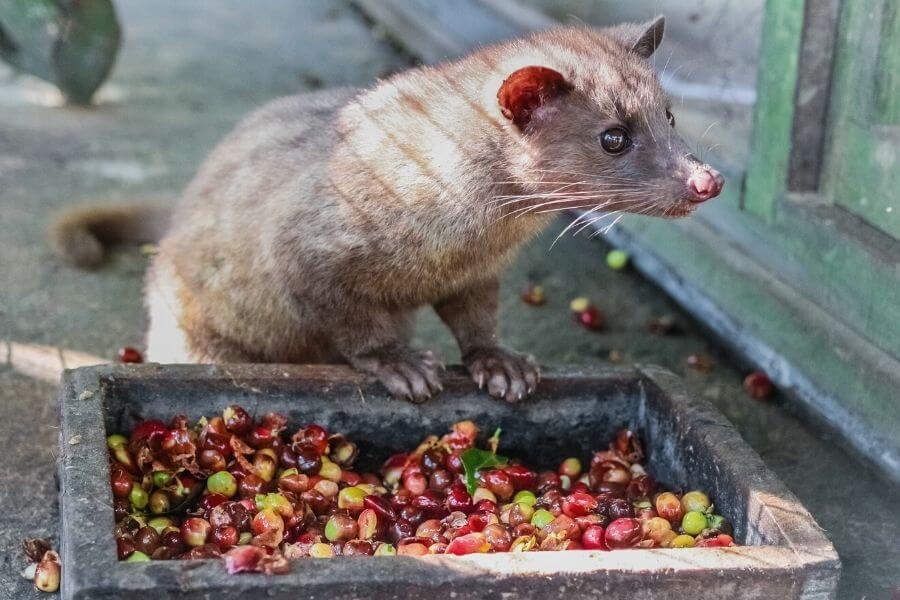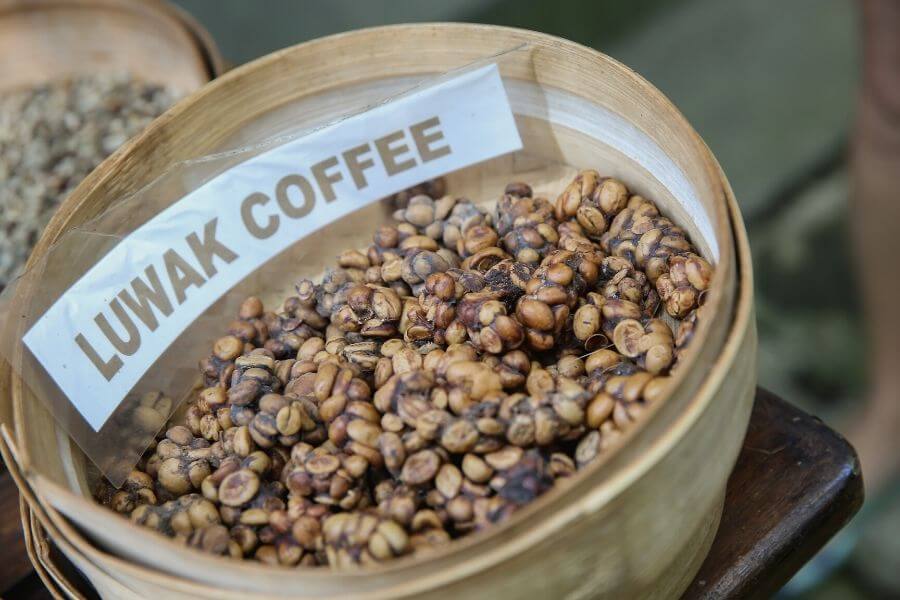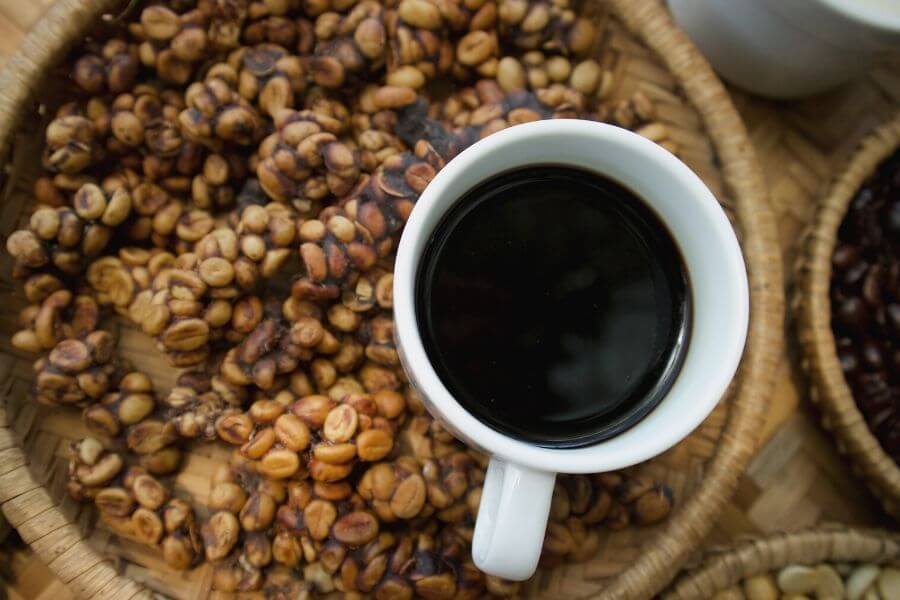Animal Poop Coffee — Is It Worth the Hype?
Stop laughing, this is serious business! Animal Poop Coffee, or Kopi Luwak as it’s officially known, is revered as the best coffee you could ever taste. It costs a pretty penny — and you won’t find it at your local grocery store. It’s as mysterious as it is hilarious.
But I can assure you, this is no joke. While it’s made from, well, animal poop, many aficionados say that Kopi Luwak is the smoothest coffee in the world, and that’s why it’s so sought after.
So, grab a cup of regular coffee — that didn’t come from an animal’s behind — and read on to find out what makes Kopi Luwak coffee one for the bucket list.
What Is Kopi Luwak?

Kopi Luwak goes by many names, including Civet Coffee and Cat Poop Coffee. As you may have guessed, it’s harvested from the fecal matter of Asian palm civets — cat-like animals native to Southeast Asia.
The legend behind Kopi Luwak is as fascinating as the coffee itself. It’s believed that it originated in Indonesia in the 1700s when Dutch coffee plantation owners forbade local workers from harvesting their crops.
The workers — upon noticing the civets eating the coffee cherries and subsequently leaving the seeds behind — got the idea to brew coffee from the dropped beans.
What started as an act of both defiance and desperation went on to become the most extravagant brew in the world. But why? And more importantly, how does poop turn into coffee in the first place?
How Kopi Luwak Is Made
First, Asian palm civets climb trees to find and eat the ripest, juiciest coffee cherries that they can reach. After 24 hours or so, the civets excrete partially digested coffee seeds.
Harvesters then collect these seeds from the civet droppings and — because I know you were worried about this — give them a thorough wash. This step rinses any residual cherry pieces away, and, of course, cleans the seeds.
From there, the process is much the same as any other coffee. The seeds are dried and roasted before they’re ground and brewed when they’re ready to become a cup of coffee.
Why The Poop? Why Not Fresh Beans?
Excellent question. There are three possible reasons that Kopi Luwak entails civet droppings.
Firstly, when civets digest coffee cherries, the protease enzymes in their stomachs ferment the coffee seeds. This process lessens the peptides in the beans, but also produces more amino acids, both of which dramatically alter the coffee’s taste.
Secondly, it’s believed that civets will only choose the best coffee cherries to eat and that by default, the seeds found in their droppings are of higher quality than beans harvested directly from coffee plants.
And thirdly, it’s the novelty of it. Since Kopi Luwak was originally made from civet droppings, it’s tradition, and some consumers want the experience as much as, if not more than, the coffee itself.
Ultimately, Kopi Luwak isn’t a type of coffee in and of itself. Asian palm civets eat whichever cherries are available to them, which is almost always Arabica and Robusta — the very same as your espresso, iced coffee, and cup of instant joe. Without the poop element, Kopi Luwak would simply be… regular coffee.

What Does Kopi Luwak Taste Like?
It’s difficult to give a definite, objective answer here because taste is subjective. Just as I cannot describe exactly what espresso, or mint chocolate, tastes like to someone who’s never had it, trying to gauge animal poop coffee’s flavor is near impossible.
Some say that the in-stomach fermentation emphasizes Arabica flavors that are usually diluted in standard coffee harvesting. Others swear that it’s not so much the taste as it is the quality — that Kopi Luwak is smoother than silk, and that the texture makes it superior to all other coffees.
Then, there are naysayers, of course, who insist that Kopi Luwak tastes exactly like it was made from poop and that it’s the worst coffee you can find. Some even go as far as to claim that the only reason people say it’s good is because of its price tag and gimmick.
Regardless of the reviews and commentary, Kopi Luwak is almost described as earthy, nutty, and musty, with hints of caramel and even chocolate.
So, in other words, civet coffee tastes like… coffee. A rich, delectable cup of regular coffee. Who’d have thought?
Is Kopi Luwak Safe?
By now, you’re well aware that regardless of its production or price, Kopi Luwak is still just coffee. Therefore, in terms of its nutritional value, yes, Kopi Luwak is perfectly healthy and carries the same benefits and drawbacks as any other cup of Arabica joe.
Since the beans are washed meticulously, there is no serious risk of fecal contamination, and as an extra measure, the roasting process also kills most of the bacteria we’re all concerned about.
Even so, there is one risk. According to Time, beans that are harvested within 24 hours of being dropped could carry a fungus that we shouldn’t consume. It’s near impossible to be sure that the poop is old enough to harvest from (a sentence I never thought I’d write), so one can never be sure if the Luwak they drink is safe for consumption.
The good news is that there are no reports of illness caused by drinking Kopi Luwak. So, if you can’t resist a cup, you can rest easy. It almost certainly won’t make you sick.
However, just because animal poop coffee is perfectly safe for human consumption, it doesn’t mean that it’s healthy for the animals we get it from…

Is Animal Poop Coffee Ethical?
In a perfect world, Kopi Luwak wouldn’t cause any harm to civets, but unfortunately, that’s not always the case. If the seeds are harvested from wild civet droppings, then sure, no problem. However, because Kopi Luwak is a trend, tourist attraction, and booming industry, not all producers of it are kind.
There are many reports of civets being kidnapped from the wild and locked in cages, only to be force-fed coffee cherries so their stomachs will work overtime. It goes without saying that this is cruel. Not to mention that often their living conditions are usually unsanitary because they’re not cared for beyond keeping them alive so they’ll poop out coffee beans.
I must note here that not all producers are mean. Some Kopi Luwak is ethically sourced, and the civets are left alone entirely. The problem is that it’s incredibly difficult to regulate — or even trace — the source of the beans.
So, if you’re vegan or live a cruelty-free lifestyle, you may want to avoid animal poop coffee entirely.
How Much Does Civet Coffee Cost?
You might want to sit down for this.
Kopi Luwak doesn’t have a set price, but most reports place it between $35 and $100 per cup, and as much as $600 per pound. It’s no secret that many who try it say that it’s a tourist trap, and not worth the money you’ll spend on it.
That said, others swear by it, and firmly believe that the price is justified by the coffee’s quality. It begs the question: Why does Kopi Luwak cost so much anyway?
No one really knows.
Originally, most people believed that Kopi Luwak’s hefty price tag was credited to its scarcity — that there was too little supply to meet demand. Hence, its worth skyrocketed. However, there are some theories that it’s the time-consuming production and labor that makes it so expensive, or that the only reason why it costs as much as it does is because it’s a novelty.
Other Types of Animal Poop Coffee

Just when you thought it couldn’t get any worse than coffee with cat poop, the world jumped on the Kopi Luwak bandwagon and created a selection of animal poop coffee for you to try. There are four different types, and they’re all just as ridiculous as the original.
Coati Poop Coffee
It goes by many names — Coatis Coffee, Mishasho Coffee, Uchunari Coffee, or even Peruvian Poop Coffee — but it’s almost exactly the same as Kopi Luwak. The only real difference is that the source is a coati, a relative of the raccoon.
Coati coffee is said to be less bitter and pungent than standard coffee. However, some tasters note that it carries hints of miscellaneous flavors — likely other berries or foods that the coati digested with the coffee cherries.
Bird Poop Coffee
Native to Brazil, the Jacu bird feeds on ripe coffee cherries and digests all but the seeds. As far as we know, only one plantation in the world produces this bird poop coffee, making it one of the rarest and most expensive brews in the world. It’s described as smooth, full-bodied, and sweet, with hints of cinnamon.
Elephant Poop Coffee
Elephant poop coffee, better known as Black Ivory Coffee, is reputed to be produced by a single plantation in Thailand. Although it’s made exactly the same way as the others, a little more time and care goes into it. For one, all the elephants that produce it are rescues. For another, it can take anywhere up to 70 hours for elephants to digest Arabica cherries.
Black Ivory Coffee is noted as smooth, chocolatey, and soft. Some describe it as possessing a malt flavor dressed with traces of cherry, while others say it’s so unique there is nothing to compare it to. It’s believed to be the rarest coffee in the world.

(Dis)honorable Mentions
Monkey coffee and bat coffee are often mislabeled as poop coffees, but they’re not. In the case of the former, monkeys chew on coffee cherries and then spit them out. Enzymes in their saliva ferment the beans, changing their flavor and appearance. As for the latter, wild bats suck the juices out of coffee cherries. The cherries then dry out and are chemically altered by traces of enzymes in the bats’ saliva.
Is Animal Poop Coffee Worth It?
Animal poop coffee sounds gross, but it’s somewhat misunderstood. It’s important to realize that it’s not made from feces and that the beans — plain old Arabica beans — are washed and processed in the same way as regular coffee. Plus, there is little to no risk in enjoying a cup of Kopi Luwak, and it’s said to taste excellent.
But only you can be the judge of whether or not it’s worth a try. I suppose ‘Don’t knock it until you’ve tried it’ applies here because there’s no way to know unless you drink it yourself.
If how it’s made doesn’t bother you, you can verify its ethicality, and you can afford to buy animal poop coffee, then I say go for it. Rather you than me!
Animal Poop Coffee FAQs
Is There Animal Poop In Coffee?
Not at all! The term “Animal Poop Coffee” describes the source of the beans, not the ingredients of the resulting joe. Phew! Animal poop coffee simply means that the coffee beans are harvested from animal droppings. But don’t worry — they’re washed, thoroughly, before they’re roasted, ground, and consumed.
What Coffee Is Made From Cat Poop?
Coffee with cat poop is a slight misnomer, as the coffee does not include cat poop, nor does it come from cats. Cat poop coffee, or Kopi Luwak, is harvested from civet droppings. As it turns out, civets aren’t cats, though they do fall into the order of feliformia, alongside cats both big and small, hyenas, and mongooses.
Is Animal Poop Coffee The Rarest Coffee In The World?
Technically, yes — but it’s not the coffee you’re thinking of. Civet coffee is fairly popular and, therefore, it’s not that difficult to get your hands on a cup if you really wanted to. Black Ivory Coffee, on the other hand, is harvested from elephant poop and is far more tricky to track down.





